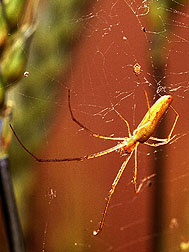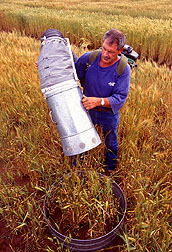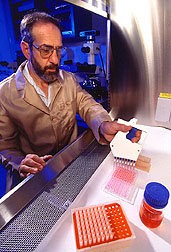Spiders the Ultimate Predator?
|
|
Researchers investigate a broad range of biological tools for control of insect pests. These include use of parasites, pathogens, growth regulators, bio-insecticides, and foreign predators.
Now, Agricultural Research Service scientists are beginning to exploit a vast reserve of untapped potential --native predators, including spiders, a neglected group of biocontrol agents.
For example, when scientists checked out a Georgia cottonfield last year, they determined that about one-fourth of the specimens of one spider species had dined on eggs of two cotton pests. In Colorado, they conducted the first North American survey for spiders that kill cereal aphids and other wheat pests.
These predators belong to the animal phylum known as arthropods --creatures with jointed legs, a segmented body, and a hard exoskeleton.
"Arthropods make up the vast majority of all known animal species,"says ARS entomologist Matthew H. Greenstone. "They include arachnids --the class that includes scorpions, mites, and spiders --as well as insects, centipedes, and millipedes."Unlike insects that have three pairs of legs, arachnids have four pairs.
"In most agricultural ecosystems,"says Greenstone, "arthropod predators are the most consistently present and abundant natural enemies of insect pests. But they have been largely neglected, mainly because their effectiveness has been difficult to demonstrate."
Greenstone works today at ARS' Plant Sciences and Water Conservation Research Laboratory in Stillwater, Oklahoma. But he started his investigations of native predators in 1982 in Columbia, Missouri, at the agency's Biological Control of Insects Research Laboratory. There he pioneered new biochemical tests to help scientists include these predators in their biocontrol research.
He believes that the most efficient and direct approach to gathering long-term data on arthropod predation is serological analysis. This means using antibodies --molecules produced by white blood cells that he grows in a special medium in his laboratory incubator --in assays to identify the remains of prey in a predator's gut.
"These assays,"he says, "must be specific, because the gut may contain not only target antigens --molecules recognized by the antibodies --but also antigens from other related species. The assays have to be highly sensitive, because the antigens often occur in exceedingly small amounts, sometimes less than a few millionths of a gram.
Gut Assays While You Wait
Greenstone pioneered use of monoclonal antibodies to analyze the predator guts. Working with ARS biological technician Clyde E. Morgan at Columbia, Greenstone used the spined soldier bug as a laboratory model to develop a fast ELISA (enzyme-linked immunosorbent assay) test. In just 2-1/2 hours, it could detect remains of cotton bollworm larvae in the soldier bug's gut.
"This test, developed in 1982, was the first to use a monoclonal antibody to study predation,"says Greenstone. "It was also the first to distinguish different growth stages of a single caterpillar species, as well as related caterpillar species."
The test distinguishes cotton bollworms from their cousins, the tobacco budworm and groundcherry fruitworm. It also recognizes three other caterpillar pests in the same family --the fall armyworm, cabbage looper, and velvetbean caterpillar --along with the imported cabbageworm.
In 1990, Greenstone, working with ARS microbiologist Melissa K. Stuart at Columbia, perfected and simplified the monoclonal antibody-based predator gut content assays. They developed a simple assay --called the immunodot --that was less expensive and faster than ELISA.
|
|
"The immunodot assay does not require the elaborate and expensive equipment needed for interpreting ELISA assays,"Greenstone says.
A few years later, Greenstone, Stuart, and entomologist James H. Hunt at the University of Missouri at St. Louis proved that the immunodot assay worked with jumping spiders and paper wasps, as well as with soldier bugs.
"Such rapid, easily interpreted assays make immunoassay technology more accessible to arthropod ecologists. That, in turn, is helping to increase our knowledge of arthropod predators' role in biocontrol,"says Greenstone. Since 1995, he has continued this work in Stillwater.
Grower Alert
Last year, Greenstone and University of Georgia entomologist John R. Ruberson collaborated on research that will alert growers as to which natural enemies are attacking budworms and bollworms in cottonfields.
"Bollworms and budworms alone cost southeastern cotton growers several hundred million dollars a year in damage and chemical controls,"says Greenstone. "To make intelligent pest management decisions, growers need to know which natural enemies are attacking these two pests."
Ruberson collected more than 3,000 predatory insects and spiders from a 30-acre cottonfield. The most important predators were big-eyed bugs, red imported fire ants, Scymnus lady beetles, and a native winter spider species, Chiracanthium inclusum.
Ruberson analyzed the creatures with the ELISA test, using Greenstone's monoclonal antibody. He found that 6.5 percent were positive for budworm and bollworm egg remains.
"This 6.5 percent appears low,"Greenstone says, "but the egg numbers themselves were fairly low during most of the season. Some predators had high rates of egg feeding, including 25 percent of the winter spiders."
The assay and insect census data will be combined to determine the relative importance of each predator in suppressing budworms and bollworms.
In Stillwater, Greenstone's new focus is biological control of cereal aphids. He and ARS biological technician Brian G. Jones recently completed the first quantitative survey of spiders in winter wheat in North America.
"Very good data from Great Britain and northern Europe show that spiders can help to control aphids in wheat and barley fields in those countries,"says Greenstone. "Surprisingly, nobody had looked at spiders in these crops on this continent.
"We surveyed winter wheat fields in southeastern Colorado and uncovered a spider fauna much more diverse than those reported in Great Britain, Northern Europe, and New Zealand. There, one family of spiders --Linyphiidae, the line- or sheet-web weavers --dominates.
In Colorado, Linyphiidae constituted just one-fifth of the spider individuals. Six other families each made up 10 percent or more,"says Greenstone.
"Now that we know the spiders, we need to develop the tools to perform gut analysis to detect Russian wheat aphids, greenbugs, and other important aphids in wheat and barley. Then we'll be able to combine gut and census data and determine which spiders and other arthropod predators are most important in wheat and barley fields."
Today, in collaboration with an independent antibody-producing facility at Oklahoma State University, Greenstone is developing monoclonal antibodies to detect the remains of three major cereal aphids --the greenbug, Russian wheat aphid, and corn leaf aphid.
Another collaborator, William O.C. Symondson of the University of Wales in Cardiff, is developing monoclonals for the English grain aphid, bird cherry oat aphid, and rose grass aphid.
"With these six antibodies,"Greenstone says, "we will be able to study the role of predators in suppressing cereal aphids in many parts of the world." --By Hank Becker, Agricultural Research Service Information Staff.
Matthew H. Greenstone is at the USDA-ARS Plant Sciences and Water Conservation Research Laboratory, 1301 N. Western St., Stillwater, OK 74075; phone (405) 624-4119, fax (405) 372-1398.
"Spiders the Ultimate Predator?" was published in the August 1998 issue of Agricultural Research magazine. Click here to see this issue's table of contents.










